Imam Kul Sharif is rightly regarded as one of the most prominent figures in the history of Kazan Khanate. His life is steeped in legend, therefore, it is difficult to tell fact from fiction today. However, Tatar ethnographer and educator Shigabutdin Mardjani, who painstakingly collected information about Kul Sharif, claimed that he actually existed, lived a remarkable life and was killed in 1552 during the storming of Kazan by Tsar Ivan the Terrible’s troops.
Kul Sharif belonged to a Seyyid family, which means that he was a direct descendant of prophet Muhammad. It is evident from his name, which consists of Turkic and Arabic words translating as a “holy slave”. Recent studies on the Seyyid family trees have shown that Kul Sharif could be the prophet’s Crimean descendant.
Kul Sharif’s date and place of birth are unknown, but indirect references suggest that he came to Kazan by 1530. Moreover, by that time he already was the spiritual leader of Kazan Muslims, who joined up to fight Ivan the Terrible. It is a known fact that Kul Sharif and his followers from among his disciples put together a fighting unit that defended one of the approaches to Kazan. All of them were killed during the assault of the city.
Kul Sharif was not only a religious figure, but also a famous poet. He is credited as the author of several poems as well as the “Book of Kazan Khanate”s Victories”. Studies of these works show that their author was a very educated and intellectual person for his time, he was well versed in history, medicine and astronomy. Moreover, the works attributed to Kul Sharif were written using an exquisite writing style.
What the legendary imam looked like is not known for certain. His portraits may have existed in the 16th century, but they have not survived the devastation of Kazan. It created doubts among historians as to whether Kul Sharif really existed. In 1998, Kazan artist Niyaz Khaziakhmetov painted his portrait creating the image of a wise, fair and fearless man. According to extant historical data, this was the kind of person Kul Sharif was. His rich clothes and the palace in the background highlight the imam’s noble birth. The author managed to accurately capture the atmosphere of ancient Kazan, not yet ruined by the tsarist troops. An old prosperous city, cultural and religious capital of Kazan Khanate, a place glorified by poets and chroniclers, which was defended even by those, who had never held a weapon in their hands.
Kul Sharif belonged to a Seyyid family, which means that he was a direct descendant of prophet Muhammad. It is evident from his name, which consists of Turkic and Arabic words translating as a “holy slave”. Recent studies on the Seyyid family trees have shown that Kul Sharif could be the prophet’s Crimean descendant.
Kul Sharif’s date and place of birth are unknown, but indirect references suggest that he came to Kazan by 1530. Moreover, by that time he already was the spiritual leader of Kazan Muslims, who joined up to fight Ivan the Terrible. It is a known fact that Kul Sharif and his followers from among his disciples put together a fighting unit that defended one of the approaches to Kazan. All of them were killed during the assault of the city.
Kul Sharif was not only a religious figure, but also a famous poet. He is credited as the author of several poems as well as the “Book of Kazan Khanate”s Victories”. Studies of these works show that their author was a very educated and intellectual person for his time, he was well versed in history, medicine and astronomy. Moreover, the works attributed to Kul Sharif were written using an exquisite writing style.
What the legendary imam looked like is not known for certain. His portraits may have existed in the 16th century, but they have not survived the devastation of Kazan. It created doubts among historians as to whether Kul Sharif really existed. In 1998, Kazan artist Niyaz Khaziakhmetov painted his portrait creating the image of a wise, fair and fearless man. According to extant historical data, this was the kind of person Kul Sharif was. His rich clothes and the palace in the background highlight the imam’s noble birth. The author managed to accurately capture the atmosphere of ancient Kazan, not yet ruined by the tsarist troops. An old prosperous city, cultural and religious capital of Kazan Khanate, a place glorified by poets and chroniclers, which was defended even by those, who had never held a weapon in their hands.


